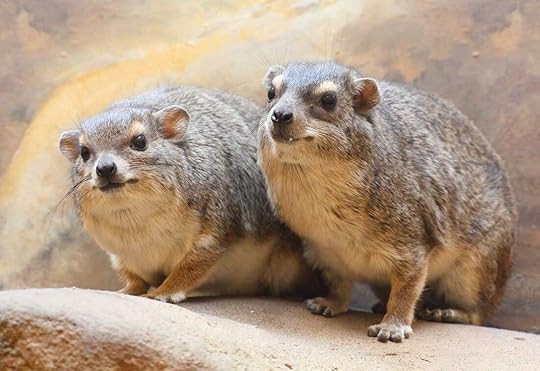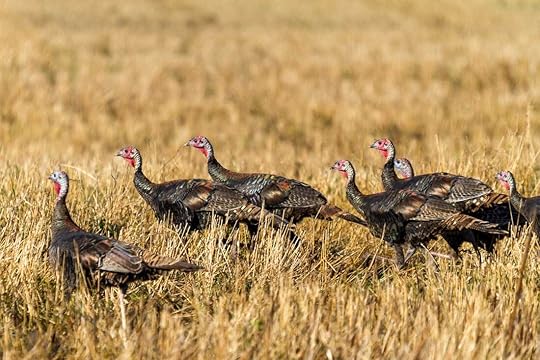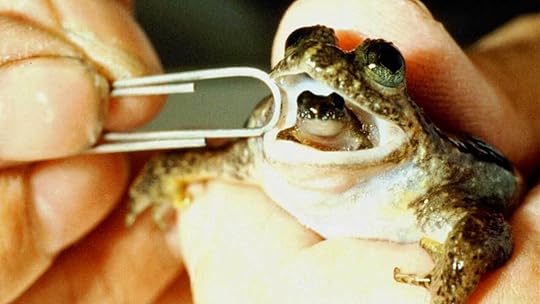Stan C. Smith's Blog, page 10
December 10, 2023
In our neck of the woods... Prickly Pear
Missouri isn't a desert state, so people don't usually think of cactuses growing here.
(by the way, many people assume cacti is the correct plural for cactus instead of cactuses. But dictionaries recognize both versions as correct, leaving it up to the writer, and I prefer cactuses because it follows standard English grammatical rules, as opposed to the Latin cacti... so, don't blast me for using cactuses!).
We do have a few cactus species here, but only one type is common enough that you might occasionally see it—the eastern prickly pear. I usually see them when I am hiking in the fall or winter because the other vegetation turns brown then, making the green prickly pear easier to spot. In the winter, the green paddle-like pads kind of dry up and become wrinkly, like this one that I found on a hillside near our house.
Like many cactuses, prickly pears have sharp spines, which grow in clusters on the flat pads. The spines help the plant in two ways. They protect the cactus from being eaten by herbivores. Also, they help the plant reproduce and spread into new areas. The flat pads break off easily, and sometimes the spines make the pads stick to the feet or fur of animals. The pad breaks off, and the animal will carry it until it drops onto the ground in a new place. The pad will then take root and grow a new plant. This is a type of asexual reproduction, called vegetative cloning.
Prickly pears also reproduce sexually, which is why they produce numerous large yellow flowers to attract bees and other pollinators.

Photo Credit:
- Prickly pear cactus - Stan C. Smith
(by the way, many people assume cacti is the correct plural for cactus instead of cactuses. But dictionaries recognize both versions as correct, leaving it up to the writer, and I prefer cactuses because it follows standard English grammatical rules, as opposed to the Latin cacti... so, don't blast me for using cactuses!).
We do have a few cactus species here, but only one type is common enough that you might occasionally see it—the eastern prickly pear. I usually see them when I am hiking in the fall or winter because the other vegetation turns brown then, making the green prickly pear easier to spot. In the winter, the green paddle-like pads kind of dry up and become wrinkly, like this one that I found on a hillside near our house.
Like many cactuses, prickly pears have sharp spines, which grow in clusters on the flat pads. The spines help the plant in two ways. They protect the cactus from being eaten by herbivores. Also, they help the plant reproduce and spread into new areas. The flat pads break off easily, and sometimes the spines make the pads stick to the feet or fur of animals. The pad breaks off, and the animal will carry it until it drops onto the ground in a new place. The pad will then take root and grow a new plant. This is a type of asexual reproduction, called vegetative cloning.
Prickly pears also reproduce sexually, which is why they produce numerous large yellow flowers to attract bees and other pollinators.

Photo Credit:
- Prickly pear cactus - Stan C. Smith
Published on December 10, 2023 05:22
December 5, 2023
Awesome Animal Fact - Rock Hyrax
Did you know the rock hyrax, though it looks kind of like a guinea pig, is actually most closely related to elephants and manatees?
Hyraxes, native to Africa and the Middle East, have teeth, toes, and skull structures similar to those of an elephant’s. This is because hyraxes and elephants share a common ancestor. Hyraxes have strong, flat molars for grinding food, and they have two incisors that grow out to be tiny tusks.
As the name suggests, rock hyraxes spend much of their time among the rocks, particularly on cliffs and hillsides.
Okay, what's all this about hyraxes, elephants, and manatees? Let's dig deeper. Throughout the late Eocene (56 to 34 million years ago), many species of hyrax-like mammals (called hyracoids) thrived in Africa and the Middle East. Some were as small as a mouse, others weighed almost 3,000 pounds (1,360 kg). The descendants of these hyracoids evolved in several diverging directions. Some became the small, modern hyraxes of today. Others moved into the water, gradually becoming the sirenians (manatees and dugongs), and some became the various elephants.
Sources often state that hyraxes are the closest relatives to the elephant family, but DNA evidence suggests that the manatees and dugongs might be closer. Still, they all share a common ancestor, and hyraxes have many resemblances to elephants, including their toenails, the shapes of many of their bones, the sensitive pads on their feet, small tusks, excellent hearing, good memory, and sophisticated brain functions compared to other mammals of similar size.

Photo Credits:
- Rock hyraxes - DepositPhotos
Hyraxes, native to Africa and the Middle East, have teeth, toes, and skull structures similar to those of an elephant’s. This is because hyraxes and elephants share a common ancestor. Hyraxes have strong, flat molars for grinding food, and they have two incisors that grow out to be tiny tusks.
As the name suggests, rock hyraxes spend much of their time among the rocks, particularly on cliffs and hillsides.
Okay, what's all this about hyraxes, elephants, and manatees? Let's dig deeper. Throughout the late Eocene (56 to 34 million years ago), many species of hyrax-like mammals (called hyracoids) thrived in Africa and the Middle East. Some were as small as a mouse, others weighed almost 3,000 pounds (1,360 kg). The descendants of these hyracoids evolved in several diverging directions. Some became the small, modern hyraxes of today. Others moved into the water, gradually becoming the sirenians (manatees and dugongs), and some became the various elephants.
Sources often state that hyraxes are the closest relatives to the elephant family, but DNA evidence suggests that the manatees and dugongs might be closer. Still, they all share a common ancestor, and hyraxes have many resemblances to elephants, including their toenails, the shapes of many of their bones, the sensitive pads on their feet, small tusks, excellent hearing, good memory, and sophisticated brain functions compared to other mammals of similar size.

Photo Credits:
- Rock hyraxes - DepositPhotos
Published on December 05, 2023 06:40
December 1, 2023
Life's Great Mysteries - When you turn off the lights, where does the light go?
I’m being serious here. Think about it… light is pretty persistent. After all, you can see stars that are many light years away. That means the light from those stars has traveled for years—even thousands of years—to get to your eyeball, and over all that distance and all that time the light has persisted. So, it seems logical to me that, in an enclosed room with no windows, the light from a flashlight should stay in the room even after you turn off the flashlight. After all, light is an electromagnetic wave that goes on forever…
But only if nothing absorbs it. Let’s say you’re in a room with no windows. You turn on a light bulb to light up the room, but the room gets dark again as soon as you turn off the bulb. Why? Because the light is quickly absorbed by the walls (and even by the air particles in the room). It happens so fast your eyes can’t detect it. It occurs to me that if the light wasn’t being absorbed, the room would get brighter and brighter the longer you left the light bulb on because the light would just continue bouncing off the walls, and the “old” light would remain in the room even as new light is being added. That’s a strange thought, but strange thoughts are the way I roll.
Okay, let's take this a step further… what if the walls of the room are mirrors? Wouldn’t the reflected light just keep bouncing around in the room for a long time? Nope. The light still disappears in an instant, due to the fact that typical mirrors do not reflect 100% of the light hitting them. Okay, then what if we had really, really good mirrors? Like, perfect mirrors that reflect 100% of the light. Well, as it turns out, the mirrors with the highest reflectivity, made for reflecting a laser beam, have a reflectivity of about 99.999%. Therefore, the light in the room of mirrors would still disappear in an instant. You have to consider how fast light travels. If you have a little cubical room that is 10 cm wide on each side, a beam of light will bounce off the walls about three billion times in one second! So, even if the walls were made of the best mirrors in the world, with 99.999% reflection, the light would be gone in a tiny fraction of a second.
So much for my idea of making a container to hold some light for when I might need it later.

Photo Credits:
- Hands holding light - DepositPhotos
But only if nothing absorbs it. Let’s say you’re in a room with no windows. You turn on a light bulb to light up the room, but the room gets dark again as soon as you turn off the bulb. Why? Because the light is quickly absorbed by the walls (and even by the air particles in the room). It happens so fast your eyes can’t detect it. It occurs to me that if the light wasn’t being absorbed, the room would get brighter and brighter the longer you left the light bulb on because the light would just continue bouncing off the walls, and the “old” light would remain in the room even as new light is being added. That’s a strange thought, but strange thoughts are the way I roll.
Okay, let's take this a step further… what if the walls of the room are mirrors? Wouldn’t the reflected light just keep bouncing around in the room for a long time? Nope. The light still disappears in an instant, due to the fact that typical mirrors do not reflect 100% of the light hitting them. Okay, then what if we had really, really good mirrors? Like, perfect mirrors that reflect 100% of the light. Well, as it turns out, the mirrors with the highest reflectivity, made for reflecting a laser beam, have a reflectivity of about 99.999%. Therefore, the light in the room of mirrors would still disappear in an instant. You have to consider how fast light travels. If you have a little cubical room that is 10 cm wide on each side, a beam of light will bounce off the walls about three billion times in one second! So, even if the walls were made of the best mirrors in the world, with 99.999% reflection, the light would be gone in a tiny fraction of a second.
So much for my idea of making a container to hold some light for when I might need it later.

Photo Credits:
- Hands holding light - DepositPhotos
Published on December 01, 2023 13:03
November 27, 2023
In our neck of the woods... Bugs and Early Settlers
The other day, Trish and I were exploring an interesting property located a mile down the road from us, called Kumberland Gap. In the 1970s, the owner carefully moved about twenty old structures to this property by dismantling them at their original locations and reconstructing them here, creating an authentic "frontier town."
Decades ago, they regularly opened the "town" as a tourist attraction. Recently, it was purchased by new owners, who intend to restore the place to its old glory.
Anyway, we were exploring the main structures (jail, grain mill, blacksmith's shop, general store, and many more), when we saw a trail back into the woods. We followed the trail and found this old homestead-type cabin.
This got me to thinking... what must it have been like to live in a place like this, deep in the woods, long before we had internet, cell phones, and other modern conveniences? And... this may surprise you, but one of the main reasons I admire those brave, resilient people is that they did not have modern insect repellant. Think about it. We have chiggers here that can ruin your whole week if you make the mistake of going into the woods for only one hour without proper protection. To the north (like in Minnesota), the mosquitoes, black flies, and deer flies will make your life miserable without insect repellent.
I know, I know... those people had to use an outhouse, they canned their own food, and they worked their fingers to the bone with countless other tasks. But I am most in awe of the fact that they did all of this without Off or Repel! I gotta respect them for that.

Photo Credit:
Kumberland Gap cabin - Stan C. Smith
Decades ago, they regularly opened the "town" as a tourist attraction. Recently, it was purchased by new owners, who intend to restore the place to its old glory.
Anyway, we were exploring the main structures (jail, grain mill, blacksmith's shop, general store, and many more), when we saw a trail back into the woods. We followed the trail and found this old homestead-type cabin.
This got me to thinking... what must it have been like to live in a place like this, deep in the woods, long before we had internet, cell phones, and other modern conveniences? And... this may surprise you, but one of the main reasons I admire those brave, resilient people is that they did not have modern insect repellant. Think about it. We have chiggers here that can ruin your whole week if you make the mistake of going into the woods for only one hour without proper protection. To the north (like in Minnesota), the mosquitoes, black flies, and deer flies will make your life miserable without insect repellent.
I know, I know... those people had to use an outhouse, they canned their own food, and they worked their fingers to the bone with countless other tasks. But I am most in awe of the fact that they did all of this without Off or Repel! I gotta respect them for that.

Photo Credit:
Kumberland Gap cabin - Stan C. Smith
Published on November 27, 2023 05:06
November 23, 2023
Awesome Animal Fact - Wild Turkeys
Did you know the wild turkeys of North America almost went extinct in the 1930s? Mainly due to overhunting and loss of their forest habitat. Actually, their decline began back in the 1600s, when European colonists began aggressively hunting them and clearing forest to make farmland.
Today, domestic turkeys are often part of a traditional Thanksgiving meal, but by 1863, when President Abraham Lincoln declared Thanksgiving an official U.S. holiday, wild turkeys were completely gone from Connecticut, Vermont, New York and Massachusetts. By the 1930s, they were nearly extinct everywhere. Thanks to intensive state and federal efforts over the last 90 years, there are now 6 to 7 million wild turkeys in North and Central America.
Let's consider a few more wild turkey tidbits. The bird's name actually comes from the name of the country, Turkey. Here's the story: In the Middle Ages, a bird called the African guinea fowl was brought to Europe, first becoming established on farms in Turkey. Eventually, the African guinea found its way to farms all over Europe, and people called it the Turkey bird. When Europeans first ventured to North America, they thought wild turkeys resembled the African guineas (Turkey birds) from back home, so they called them turkeys.
Domestic turkeys (as opposed to wild turkeys) did not originate in the United States. They have a rather interesting history. The Mayans of southern Mexico were the first to domesticate turkeys, about 2,000 years ago. Early Spanish explorers took some of these domesticated turkeys back home with them, and before long, domestic turkeys became common on farms throughout Europe. Then, when Europeans began migrating to the eastern United Sates, they brought domestic turkeys with them, completing a "turkey circle" back to North America.
So, domestic turkeys are not descendants of the wild turkey subspecies that live in the U.S. Instead, they came, via Europe, from a subspecies of southern Mexico.
Confusing, huh?

Photo Credit:
- Wild turkeys - DepositPhotos
Today, domestic turkeys are often part of a traditional Thanksgiving meal, but by 1863, when President Abraham Lincoln declared Thanksgiving an official U.S. holiday, wild turkeys were completely gone from Connecticut, Vermont, New York and Massachusetts. By the 1930s, they were nearly extinct everywhere. Thanks to intensive state and federal efforts over the last 90 years, there are now 6 to 7 million wild turkeys in North and Central America.
Let's consider a few more wild turkey tidbits. The bird's name actually comes from the name of the country, Turkey. Here's the story: In the Middle Ages, a bird called the African guinea fowl was brought to Europe, first becoming established on farms in Turkey. Eventually, the African guinea found its way to farms all over Europe, and people called it the Turkey bird. When Europeans first ventured to North America, they thought wild turkeys resembled the African guineas (Turkey birds) from back home, so they called them turkeys.
Domestic turkeys (as opposed to wild turkeys) did not originate in the United States. They have a rather interesting history. The Mayans of southern Mexico were the first to domesticate turkeys, about 2,000 years ago. Early Spanish explorers took some of these domesticated turkeys back home with them, and before long, domestic turkeys became common on farms throughout Europe. Then, when Europeans began migrating to the eastern United Sates, they brought domestic turkeys with them, completing a "turkey circle" back to North America.
So, domestic turkeys are not descendants of the wild turkey subspecies that live in the U.S. Instead, they came, via Europe, from a subspecies of southern Mexico.
Confusing, huh?

Photo Credit:
- Wild turkeys - DepositPhotos
Published on November 23, 2023 07:38
November 19, 2023
Life's Great Mysteries - Why does staring at the stars fill us with such a sense of awe?
We’ve all experienced it. We gaze up at the stars at night, and it gives us a strange feeling. Suddenly, we have questions we don’t normally think of. Even people who don’t normally give a hoot about science suddenly understand why scientists are so drawn to the mysteries of the universe.
It’s not only the stars that have this effect. A view of any breathtaking scene can do the trick. The dramatic play of light on ominous clouds following a thunderstorm. A vast landscape of mountains, or prairie, or forest. The Grand Canyon. A coral reef, teeming with brightly-colored fish and invertebrates. The list could go on. Personally, I get the same feeling when I look at tiny things through a microscope, seeing a hidden world on the surface of an insect’s head, for example. The point is, looking at certain things gives us a sense of awe. Why? And what is awe anyway?
“Awe is the feeling of being in the presence of something vast that transcends your understanding of the world.” This is a quote from Greater Good Magazine, and I think it sums it up nicely. However, different people experience awe in different ways. Awe does not have to come just from looking at the stars. I feel awe when I watch a music performer I have admired all my life. I feel awe when I watch a spectacular movie, such as Avatar. I feel awe when I read a book that is so well written that I cannot put it down.
I’m beginning to realize it is important to seek out new ways to experience awe. We should learn to feel awe as we watch the maple leaves turn orange in the fall. We should feel awe when we see a child laugh or smile just like their parents, or when we see someone give money to a homeless person. We should feel awe every time we find a crinoid fossil on a lake shore, or see a T. Rex skeleton in a museum. We should learn to feel awe as often as a four-year old child does.
Awe has evolutionary roots. Historically, awe would bring people together, bound by fascination, to achieve the same objectives. Unfortunately, awe is becoming endangered as people spend more time indoors and working mind-numbing jobs. Awe can be found indoors, but it is much easier to find outdoors. Not only that, but if people forget how to feel awe at the natural world, we will have lost what it means to be human.
Remember to look up at the stars.

It’s not only the stars that have this effect. A view of any breathtaking scene can do the trick. The dramatic play of light on ominous clouds following a thunderstorm. A vast landscape of mountains, or prairie, or forest. The Grand Canyon. A coral reef, teeming with brightly-colored fish and invertebrates. The list could go on. Personally, I get the same feeling when I look at tiny things through a microscope, seeing a hidden world on the surface of an insect’s head, for example. The point is, looking at certain things gives us a sense of awe. Why? And what is awe anyway?
“Awe is the feeling of being in the presence of something vast that transcends your understanding of the world.” This is a quote from Greater Good Magazine, and I think it sums it up nicely. However, different people experience awe in different ways. Awe does not have to come just from looking at the stars. I feel awe when I watch a music performer I have admired all my life. I feel awe when I watch a spectacular movie, such as Avatar. I feel awe when I read a book that is so well written that I cannot put it down.
I’m beginning to realize it is important to seek out new ways to experience awe. We should learn to feel awe as we watch the maple leaves turn orange in the fall. We should feel awe when we see a child laugh or smile just like their parents, or when we see someone give money to a homeless person. We should feel awe every time we find a crinoid fossil on a lake shore, or see a T. Rex skeleton in a museum. We should learn to feel awe as often as a four-year old child does.
Awe has evolutionary roots. Historically, awe would bring people together, bound by fascination, to achieve the same objectives. Unfortunately, awe is becoming endangered as people spend more time indoors and working mind-numbing jobs. Awe can be found indoors, but it is much easier to find outdoors. Not only that, but if people forget how to feel awe at the natural world, we will have lost what it means to be human.
Remember to look up at the stars.

Published on November 19, 2023 06:29
November 14, 2023
In Our Neck of the Woods - Eastern Chipmunks
The rodents are preparing for winter. Example: Trish bought a brand new car a few months ago. A few days ago, she lifted the hood to see if rodents were causing damage (a common problem here), and she discovered some little rascal was making an impressive nest on top of the engine. And chewing on wires.
The squirrels are busy burying acorns and walnuts. And here is an eastern chipmunk that was stuffing corn into its cheek pouches in our yard.
Eastern chipmunks, the only chipmunk species in Missouri, are fairly common in our area. The genus name for these chipmunks is Tamias, a Greek word meaning "a storer." Chipmunks enthusiastically gather nuts and seeds, stuff them into their cheek pouches, and carry them to their nests to build up a supply for lean times. When I say they do it enthusiastically, I mean it—a single chipmunk will usually create a cache of about a half bushel (about 4 US gallons) of seeds and nuts.
Okay, let's do some math. Eastern Chipmunks weigh about 3.5 ounces on average. A half bushel of corn weighs 26 pounds, so I'm going to estimate that a half bushel of various nuts weighs somewhat less, let's say 20 pounds, or 320 ounces. So, a 3.5-ounce chipmunk regularly gathers and hides 92 times its own weight in seeds.
Now let's imagine I'm a chipmunk, at my normal weight of 185 pounds. I would have to scour the forest floor for seeds, stuffing my cheeks full, and carrying the seeds to my nest, over and over again until I have 17,020 pounds of seeds.
Respect to the chipmunks of the world.

The squirrels are busy burying acorns and walnuts. And here is an eastern chipmunk that was stuffing corn into its cheek pouches in our yard.
Eastern chipmunks, the only chipmunk species in Missouri, are fairly common in our area. The genus name for these chipmunks is Tamias, a Greek word meaning "a storer." Chipmunks enthusiastically gather nuts and seeds, stuff them into their cheek pouches, and carry them to their nests to build up a supply for lean times. When I say they do it enthusiastically, I mean it—a single chipmunk will usually create a cache of about a half bushel (about 4 US gallons) of seeds and nuts.
Okay, let's do some math. Eastern Chipmunks weigh about 3.5 ounces on average. A half bushel of corn weighs 26 pounds, so I'm going to estimate that a half bushel of various nuts weighs somewhat less, let's say 20 pounds, or 320 ounces. So, a 3.5-ounce chipmunk regularly gathers and hides 92 times its own weight in seeds.
Now let's imagine I'm a chipmunk, at my normal weight of 185 pounds. I would have to scour the forest floor for seeds, stuffing my cheeks full, and carrying the seeds to my nest, over and over again until I have 17,020 pounds of seeds.
Respect to the chipmunks of the world.

Published on November 14, 2023 06:02
November 10, 2023
Awesome Animal Fact - Frilled Shark - A Living Fossil
Did you know the frilled shark has hardly changed (as a species) in 80 million years? Therefore, it is called a "living fossil."
This primitive shark, which is extremely rare, lives in deep water, usually 50–200 meters (160–660 ft) below the surface, and much deeper during warmer months of the year. They are long and eel-like, with characteristics of some of the most ancient fossilized sharks. They grow to about 6 feet (2 m) long and live about 25 years. Because they are rarely seen alive, little is known about their behavior.
They get the name frilled from the numerous tips of their gills that stick out beyond the edges of their gill covers.
Frilled sharks have about 300 teeth, arranged in clusters and pointing backward to help prevent their prey from escaping. They eat fish, squid, octopus, cuttlefish, and sea slugs (nudibranchs). Squid make up about 60% of their diet. This information is based on stomach contents and structural features observed in dead frilled sharks, because live frilled sharks have rarely been observed in the wild, and they are extremely difficult to keep alive in captivity.
No one knows how many frilled sharks remain, but because they are sometimes accidentally caught in fishing nets (resulting in their death), and because they reproduce very slowly, they have been classified as "near-threat of extinction."

Photo Credit:
Frilled shark - Citron / CC-BY-SA-3.0 via Wikimedia Commons
This primitive shark, which is extremely rare, lives in deep water, usually 50–200 meters (160–660 ft) below the surface, and much deeper during warmer months of the year. They are long and eel-like, with characteristics of some of the most ancient fossilized sharks. They grow to about 6 feet (2 m) long and live about 25 years. Because they are rarely seen alive, little is known about their behavior.
They get the name frilled from the numerous tips of their gills that stick out beyond the edges of their gill covers.
Frilled sharks have about 300 teeth, arranged in clusters and pointing backward to help prevent their prey from escaping. They eat fish, squid, octopus, cuttlefish, and sea slugs (nudibranchs). Squid make up about 60% of their diet. This information is based on stomach contents and structural features observed in dead frilled sharks, because live frilled sharks have rarely been observed in the wild, and they are extremely difficult to keep alive in captivity.
No one knows how many frilled sharks remain, but because they are sometimes accidentally caught in fishing nets (resulting in their death), and because they reproduce very slowly, they have been classified as "near-threat of extinction."

Photo Credit:
Frilled shark - Citron / CC-BY-SA-3.0 via Wikimedia Commons
Published on November 10, 2023 05:42
November 6, 2023
Life's Great Mysteries - Why do I eat more when I'm with family and friends?
It's true, right? At holiday gatherings, family reunions, or just about any other gathering of the people we are fond of, we eat more than we normally do. I used to think this was just me, because I often perceive that everyone else around me is eating far less than I am. Getting together with others seems to trigger something in my mind, and I lose control, like a shark in a feeding frenzy, going after buckets and buckets of chum. However, a bit of research reveals that I am not alone in my temporary, get-together, food-snarfing insanity.
My first thought, when examining this mystery, was what I’ll call the “litter of piglets” scenario (I am not calling my family a litter of piglets… it’s just an analogy). Perhaps you’ve seen a litter of piglets struggling for access to the sow’s teats, when there are often fewer teats than there are piglets. With limited food, the piglets have to get as much as they can. Maybe that’s why I eat more when I’m around other people? Well, this hypothesis doesn't hold up, because I do not have a tendency to shove everyone out of the way to get to the taco bar first. So, forget the “litter of piglets” scenario.
What, then, causes this phenomenon? Decades of research reveals that the vast majority of people do indeed eat more when in the company of others. In fact, psychologists have called this the “single most important and all-pervasive influence on eating yet identified.” Wow, harsh—especially when I'm the poster child for this behavior.
Surprisingly, some researchers have ruled out hunger, mood, or distracting social interactions as important factors. Instead, they put the blame squarely on the length of the meals. When people are together, they simply eat for a longer period of time. They enjoy talking and laughing together, and they sit around the table (or stand around the food) for much longer than they normally would. Extra minutes at the table = extra food stuffed into the mouth. Studies show that bigger groups enjoy longer meals, and when the meal times are limited, they eat no more, on average, than when they are alone. In other words, we eat the same amount of food per minute, whether we are alone or in a group, but groups eat longer.
It’s simple math, dude.

Photo Credits:
- People eating together - DepositPhotos
My first thought, when examining this mystery, was what I’ll call the “litter of piglets” scenario (I am not calling my family a litter of piglets… it’s just an analogy). Perhaps you’ve seen a litter of piglets struggling for access to the sow’s teats, when there are often fewer teats than there are piglets. With limited food, the piglets have to get as much as they can. Maybe that’s why I eat more when I’m around other people? Well, this hypothesis doesn't hold up, because I do not have a tendency to shove everyone out of the way to get to the taco bar first. So, forget the “litter of piglets” scenario.
What, then, causes this phenomenon? Decades of research reveals that the vast majority of people do indeed eat more when in the company of others. In fact, psychologists have called this the “single most important and all-pervasive influence on eating yet identified.” Wow, harsh—especially when I'm the poster child for this behavior.
Surprisingly, some researchers have ruled out hunger, mood, or distracting social interactions as important factors. Instead, they put the blame squarely on the length of the meals. When people are together, they simply eat for a longer period of time. They enjoy talking and laughing together, and they sit around the table (or stand around the food) for much longer than they normally would. Extra minutes at the table = extra food stuffed into the mouth. Studies show that bigger groups enjoy longer meals, and when the meal times are limited, they eat no more, on average, than when they are alone. In other words, we eat the same amount of food per minute, whether we are alone or in a group, but groups eat longer.
It’s simple math, dude.

Photo Credits:
- People eating together - DepositPhotos
Published on November 06, 2023 05:31
October 26, 2023
Awesome Animal Fact - Gastric-Brooding Frog
Did you know the now extinct gastric-brooding frog barfed up its babies? Yep, two species of these frogs, which lived in Queensland, Australia and became extinct in the 1980s, were unique among frogs because they incubated and hatched their eggs within the female's stomach. Really.
Let's break it down. Like other frogs, female gastric-brooding frogs laid their eggs, then the males fertilized them outside of the female's body. That's just how frogs do it, and it's normal. But then, with these frogs, things got strange. Next, the females swallowed the fertilized eggs... about 40 of them!
Hey! Wouldn't the female's stomach digest the eggs and kill them? Sure, except that these frog eggs secreted a chemical that made the mother's stomach stop producing hydrochloric acid. Well, that means the mother couldn't eat anything the entire time the eggs were incubating in her stomach and while the baby frogs were growing—more than six weeks.
Obviously, the mother's stomach got pretty large as the young grew. So large that her lungs were smashed, and she had to breathe through her skin instead.
When the babies became fully-formed frogs, the mother would barf them up, usually one at a time. But, if the mother was disturbed by something, she would projectile vomit all the babies out at once.
Unfortunately, gastric-brooding frogs went extinct due to human destruction of their habitat and human introduction of a disease-causing fungus. Amazingly, scientists are making good progress in bringing these frogs back, using a specific kind of cloning called somatic-cell nuclear transfer. In fact, in 2013, they produced a living embryo using preserved tissue from dead gastric-brooding frogs. That embryo didn't survive, but one of the scientists has stated: "We do expect to get this guy hopping again."

Photo Credits:
- Gastric-brooding frog - screenshot from YouTube video
Let's break it down. Like other frogs, female gastric-brooding frogs laid their eggs, then the males fertilized them outside of the female's body. That's just how frogs do it, and it's normal. But then, with these frogs, things got strange. Next, the females swallowed the fertilized eggs... about 40 of them!
Hey! Wouldn't the female's stomach digest the eggs and kill them? Sure, except that these frog eggs secreted a chemical that made the mother's stomach stop producing hydrochloric acid. Well, that means the mother couldn't eat anything the entire time the eggs were incubating in her stomach and while the baby frogs were growing—more than six weeks.
Obviously, the mother's stomach got pretty large as the young grew. So large that her lungs were smashed, and she had to breathe through her skin instead.
When the babies became fully-formed frogs, the mother would barf them up, usually one at a time. But, if the mother was disturbed by something, she would projectile vomit all the babies out at once.
Unfortunately, gastric-brooding frogs went extinct due to human destruction of their habitat and human introduction of a disease-causing fungus. Amazingly, scientists are making good progress in bringing these frogs back, using a specific kind of cloning called somatic-cell nuclear transfer. In fact, in 2013, they produced a living embryo using preserved tissue from dead gastric-brooding frogs. That embryo didn't survive, but one of the scientists has stated: "We do expect to get this guy hopping again."

Photo Credits:
- Gastric-brooding frog - screenshot from YouTube video
Published on October 26, 2023 18:19



